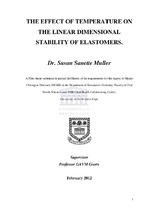| dc.description.abstract | Sometimes, dental impressions need to be transported to distant laboratories. It has been reported that the temperature in a vehicle can reach up to 66C when the outdoor temperature is 38C. These temperatures may be reached during South African summers. The objective of this in vitro study was to investigate the effect of temperature and time on the dimensional stability of two elastomeric impression materials. Methodology: Specimens consisted of impressions made of an ISO-specified test-block featuring a pattern of grooves. Materials used were polyether (Impregum Penta) and polyvinylsiloxane (Affinis Precious regular body). Using an SLR camera and standardized technique, the specimens were photographed at 2 different temperatures (21°C and 66°C) and 3 time intervals (30min, 8hrs and 14 days). This resulted in a total of 12 groups (n=10) to be compared. Digital images of the impressions were calibrated and measured using digital analyzing software. These distances were used to evaluate the mean % dimensional change (%DC) for each group. VEPAC module of Statistica 10 was used for the statistical analysis. To analyze exactly where the differences lied, a Fisher LSD correction was applied to correct for multiple pair wise comparisons. Results: Comparing polyether with silicone, there was no difference in the mean %DC for specimens kept at 21°C for 8hrs (polyether=0.364; silicone=0.237). Neither was there a difference between polyether and silicone when heated to 66°C, cooled off, and measured after 8hrs (polyether=0.306; silicone=0.297) or after 14 days (polyether=-0.272; silicone=-0.093). For both polyether and silicone, the mean %DC of the groups exposed to 66°C, cooled off and measured after 8hrs (polyether=0.306; silicone=0.297) differed significantly when compared to the group measured after 14 days (polyether=-0.2723; silicone=-0.092) (P<0.0001 and P=0.0029 resp). For both polyether and silicone, the mean %DC of the groups exposed to 66°C, cooled off and measured after 8hrs (polyether=0.306; silicone=0.297) did not differ when compared to the 21°C (polyether=0.364; silicone=0.237). Conclusions: Within limitations of this study, both materials were heat-sensitive. It is recommended that materials return to 21°C before casting. Despite statistical differences, all results were within ISO specifications of maximum 1.5%DC. | en_US |

